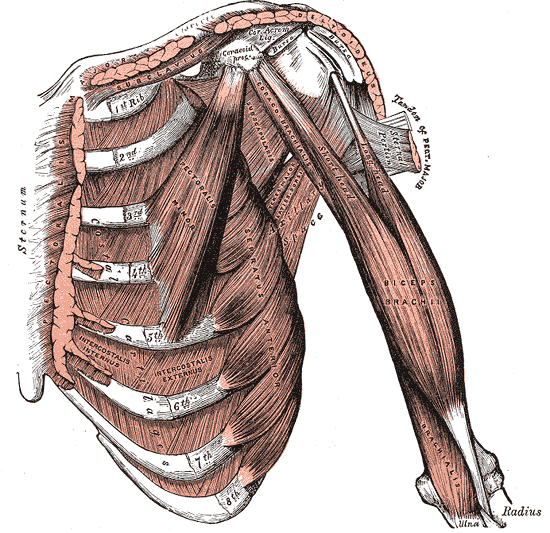Pectoral Muscle on:
[Wikipedia]
[Google]
[Amazon]
 Pectoral muscles (colloquially referred to as "pecs") are the muscles that connect the front of the human
Pectoral muscles (colloquially referred to as "pecs") are the muscles that connect the front of the human  Pectoralis major is a thick, fan-shaped or triangular
Pectoralis major is a thick, fan-shaped or triangular
 Pectoral muscles (colloquially referred to as "pecs") are the muscles that connect the front of the human
Pectoral muscles (colloquially referred to as "pecs") are the muscles that connect the front of the human chest
The thorax or chest is a part of the anatomy of humans, mammals, and other tetrapod animals located between the neck and the abdomen. In insects, crustaceans, and the extinct trilobites, the thorax is one of the three main divisions of the crea ...
with the bones of the upper arm and shoulder. This region contains four muscles that provide movements to the upper limbs or ribs.
 Pectoralis major is a thick, fan-shaped or triangular
Pectoralis major is a thick, fan-shaped or triangular convergent muscle
Muscle architecture is the physical arrangement of muscle fibers at the macroscopic level that determines a muscle’s mechanical function. There are several different muscle architecture types including: parallel, pennate and hydrostats. Force p ...
, which makes up the bulk of the chest muscle. It lies under the breast
The breast is one of two prominences located on the upper ventral region of a primate's torso. Both females and males develop breasts from the same embryological tissues.
In females, it serves as the mammary gland, which produces and sec ...
. It serves to flex, extend, and rotate the humerus, the long bone of the upper arm.
Pectoralis minor
Pectoralis minor muscle () is a thin, triangular muscle, situated at the upper part of the chest, beneath the pectoralis major in the human body.
Structure
Attachments
Pectoralis minor muscle arises from the upper margins and outer surfaces ...
is a thin, triangular muscle located beneath the pectoralis major. It attaches to the ribs, and serves to stabilize the scapula
The scapula (plural scapulae or scapulas), also known as the shoulder blade, is the bone that connects the humerus (upper arm bone) with the clavicle (collar bone). Like their connected bones, the scapulae are paired, with each scapula on eith ...
, the large bone of the shoulder.
The pectoral fascia
The pectoral fascia is a thin lamina, covering the surface of the pectoralis major, and sending numerous prolongations between its fasciculi: it is attached, in the middle line, to the front of the sternum; above, to the clavicle; laterally and bel ...
is a thin layer of tissue over the pectoralis major, extending toward the latissimus dorsi muscle
The latissimus dorsi () is a large, flat muscle on the back that stretches to the sides, behind the arm, and is partly covered by the trapezius on the back near the midline. The word latissimus dorsi (plural: ''latissimi dorsorum'') comes from L ...
on the back.
Along with the pectoralis major and pectoralis minor, the subclavius muscle
The subclavius is a small triangular muscle, placed between the clavicle and the first rib. Along with the pectoralis major and pectoralis minor muscles, the subclavius muscle makes up the anterior axioappendicular muscles, also known as anterior ...
forms the axilla
The axilla (also, armpit, underarm or oxter) is the area on the human body directly under the shoulder joint. It includes the axillary space, an anatomical space within the shoulder girdle between the arm and the thoracic cage, bounded superior ...
or armpit. The subclavius moves the shoulder downward and forward.
Serratus anterior
The serratus anterior is a muscle that originates on the surface of the 1st to 8th ribs at the side of the chest and inserts along the entire anterior length of the medial border of the scapula. The serratus anterior acts to pull the scapula fo ...
is another muscle on the front of the chest. It moves the scapula forward around the torso, as when throwing a punch
Punch commonly refers to:
* Punch (combat), a strike made using the hand closed into a fist
* Punch (drink), a wide assortment of drinks, non-alcoholic or alcoholic, generally containing fruit or fruit juice
Punch may also refer to:
Places
* Pun ...
.
Between the ribs are various groups of intercostal muscle
Intercostal muscles are many different groups of muscles that run between the ribs, and help form and move the chest wall. The intercostal muscles are mainly involved in the mechanical aspect of breathing by helping expand and shrink the size of ...
s, which help with breathing.
References
* {{cite book, last1=Gray, first1=Henry, last2=Lewis, first2=Warren, year=1918, title=Anatomy of the Human Body, location=Philadelphia and New York, publisher=Lea and Feibiger, edition=twentieth, url=https://archive.org/details/anatomyofhumanbo1918gray, access-date=13 September 2016 Muscles of the torso Broad-concept articles Human anatomy